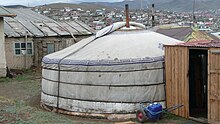At 1,564,116 square kilometres (603,909 sq mi), Mongolia is the 19th largest and the most sparsely populated independent country in the world, with a population of around 3.2 million people.
The country came under strong Russian influence and, proclaiming in 1924 the communist Mongolian People's Republic, it became Soviet Union's satellite state.[12] It was only after the breakdown of communist regimes in Europe in late 1989, when Mongolia saw its own Democratic Revolution in early 1990; it led to a multi-party system, a new constitution of 1992, and transition to a market economy.
The country contains very little arable land, as much of its area is covered by steppes, with mountains to the north and west and the Gobi Desert to the south. Approximately 30% of the population are nomadic or semi-nomadic. The predominant religion in Mongolia is Tibetan Buddhism, and the majority of the state's citizens are of Mongol ethnicity, although Kazakhs, Tuvans, and other minorities also live in the country, especially in the west. About 20% of the population live on less than US$1.25 per day

Ulaanbaatar is the capital and largest city of Mongolia

In settlementIs, many families live in ger quarters
Economic activity in Mongolia has traditionally been based on herding and agriculture, although development of extensive mineral deposits of copper, coal, molybdenum, tin, tungsten, and gold have emerged as a driver of industrial production.[45] Besides mining (21.8% of GDP) and agriculture (16% of GDP), dominant industries in the composition of GDP are wholesale and retail trade and service, transportation and storage, and real estate activities
